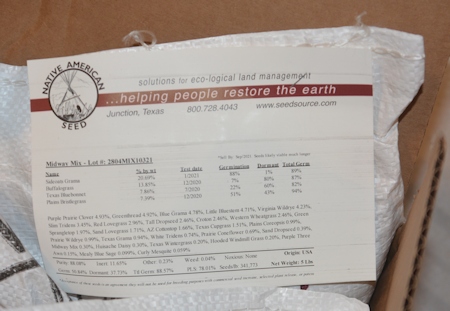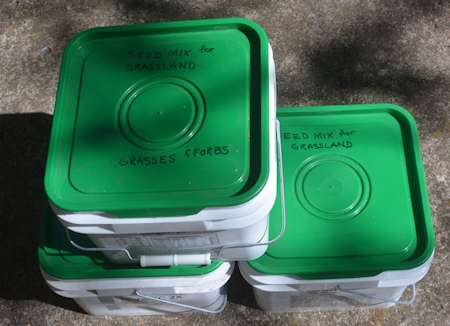What you’re told, in the management books, is that after a planned fire, everything comes back just fine. Wild fires tend to be hotter, get out of control faster, and do more damage because they occur in the hottest weather when fire departments hope to goodness no fires start. There are enthusiasts for “prescribed fires.” There are no enthusiasts for unprescribed burns. I’m not an enthusiast for either, in today’s heating world, but Stuff Happens. It’s always caused, usually by human error of some kind.
We have been lucky to have two rains (one about two inches last week, about a week after the fire, and one about four tenths of an inch last night.) Between the fire and the first of those rains we walked the entire fire scar and ordered seed to assist recovery. The seed came in and this is what it looked like:

‘

Two sacks of seed in a box, and seed in one of the sherbet containers we first carried out to the burn scar (light on the way out, even lighter on the way in.) And the content list for the seeds…that’s a lot of species, but that’s what prairies are, a mix of many species, each finding its own favorite habitat within the land. Later we decided to carry the seed out in larger containers, Strongid ™ horse wormer tubs. (Strongid used to come in VERY useful 5 gallon buckets, but I admit these are easier to use for sowing seed. I also use them to store sacks of beans and pasta. But they’re not nearly as good as 5 gallon buckets for sitting on (too low), or carrying tools in the garden cart, or using for mounting blocks or storing 25 pounds of flour .)

But the grass seeds in this mix won’t germinate in fall, only in spring/summer so only the forbs matter now. Meanwhile what really matters is the seedstock *in* the soil, and the root depth of the perennial grasses there when the fire burned their tops off, and the remaining leaves and rootlets of the trees that aren’t killed outright. We had nothing to do with those but hope, because we had no way to water them except rainfall. The trees and shrubs turned various dead brown and gray shades, where they weren’t black. Some still had green at the very top, or on the far side, but they looked bad.
By today, it was clear that a lot of the grass was still alive, and so were some of the forbs (I didn’t take a picture of the tiny forb cotyledons, the first pair of leaves that come out of the seed, because I was busy planting and as I got tireder my hands got shakier.
Here’s one view of the existing grasses. The coverage isn’t even and there are still large bare patches, but overall the field looks green….ish. Bright greenish. 98% of the green is grass sprouts, some already four inches tall, and each coming out of the burned crown (and using the roots) of a former clump of grass. They’re not all alike. In the distance the yellowish green is broomweed (undesirable, on the whole) which didn’t get burned, and which “poisons” the grass that tries to grow under it. It smells like citronella. The blacker the ground, the hotter the fire was right there. The forbs are just starting to poke through. The forb seeds we planted today should sprout after the rain that’s due the rest of the week.

But what about the trees, those grand old Live Oaks and one Post Oak just over the north boundary fence? Slower to bounce back than the perennial grasses, the oaks took their own sweet time pushing nutrients and water up from the ground and out to their limbs. Some buds were burnt, many twigs were scorched, along with the deadleaves. But….
This happened. and this happened
and this happened
 and then this…
and then this…

And this…because live oaks drop leaves in late winter/spring (depending on individuals & weather) and then bloom…this last young oak is putting out florets that will allow it to spread its pollen on the wind, as Oaks do, and have offspring. So *there*, fire, says the young oak. Ha. I am an Oak; I live centuries, you live but a short time…New buds, from new sites on twigs, bundles of leaves folded tight and floral parts about to expand. The ground under the oaks is covered with the tan leaves killed by the fire, more dropping with every wind, but “Aten’t Dead Yet.”
One may be dying (no sign of green yet from it) and another is grievously scorched, but I’m grateful for their toughness as well as their shade and the habitat they provide for other creatures.

Hi – I am glad to see that only after a short time the vegetation is coming back. Many years ago there was a major ice storm up here in New Hampshire that clipped off the tops of many trees – you can still see the effects, but surprisingly the trees, for the most part, have not died.
Planned fires – won’t it get rather expensive to have your lawnmower get on fire when you need a fire outdoors. Laughter. Was it due to just a very old mower or some maintenance that was done improperly? I am glad that no one was hurt.
Stay safe and sane and enjoy the fall.
Jonathan up here in New Hampshire
It was due to mowing thick weeds in very low humidity in hot weather and a hot engine. That mower had caused ignitions before…little ones, on more humid days, with cut material accumulating on the mower deck esp when cutting really tall stuff. The mower deck, positioned partly under the engine, allowed engine heat to quickly dry cut material and then ignite it. R- carefully cleaned off the mower deck after every session, so it wouldn’t start the work with dry stuff to burn.
But…hot weather, humidity in the one-digit category, and he’d cut a path through grasses around 4-6 feet tall before getting to the area with ragweed and broomweed. So…BOOM, then flames, then calling 911 for the first time ever and waiting for the fire trucks to come because we couldn’t fight it.
Expensive way to get rid of a crappy riding mower, for sure.
Having moved to the Yellowstone area for grad school (and where I first found Paksworld) just as the big one was being mopped up (Nat. Guard trucks were still running through town) and seeing the vegetation come back over the next two years (much quicker than was thought it would) I hope with all your effort and the much less intense fire you will continue to see the land come back. Praying for rain for you–we’re supposed to get a deluge tomorrow here.
It is good to read and see so much is coming back even before you sow the boughten seeds. I hope the one oak is just taking it’s own sweet time, rather than actually being dead.
I’m glad the green seems to be coming back. Hope you have lots of lovely grass and wildflowers to come. Texas bluebonnets?
Bluebonnets are in the planting mix, yes. There were always more gaillaria than bluebonnets in the area of the burn, except up near the dry woods…we don’t know yet which of the forb seeds will come up. The next shipment arrived and I’m about to go out and plant more (it’s about 1:15 pm with the next heavy rain due about or after 4 pm. So I’m zipping away from here.)
Gaillardia, not gaillaria…finger-fail.
It started to rain, just a bit, but I didn’t want water to get into the open tub of seed (first tub was already on the ground) so pulled my shirt out over it for a tent, got back to where I’d stowed the tops, and put the cover on. Then walked back home, by which time it had stopped raining and gotten hotter. Steam bath. Then, tired, lay down and went to sleep for a couple of hours.
1.9 inches last night near the house. (Storm rain being what it is, the far end could have more or less, and overall across the 80 acres could vary…we had a late burst of hard rain hours after the rain had gone “soft”, which could’ve been a simple hard shower w/in a band of lighter stuff.) 2 inches or less is usually absorbed by the land these days. It used to flash-flood and sheet-erode down the east grass and secondary drainage into the near meadow. Grass does a great job of slowing and cleaning up dirty water. I’m about to go out and check the near meadow and maybe (depending on mud and energy) get up to the edge of the burn scar. Two inches of rain will make *that* have some surface flow and deepen the mud and I don’t really want to be mud to the knees…the boots for that are much heavier than the short mud boots. But everything should grow like crazy that’s capable of sprouting in the fall. And next spring I’ll order in more shortgrass turf grass seed for repairing existing trails, and areas we want to keep mowed for fire management. Like wider mowed paths inside fencerow woody stuff. Anyway, it’s time to get into the short rubber boots and out there.